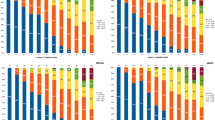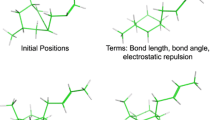Summary
Mutual binding between a ligand of low molecular weight and its macromolecular receptor demands structural complementarity of both species at the recognition site. To predict binding properties of new molecules before synthesis, information about possible conformations of drug molecules at the active site is required, especially if the 3D structure of the receptor is not known. The statistical analysis of small-molecule crystal data allows one to elucidate conformational preferences of molecular fragments and accordingly to compile libraries of putative ligand conformations. A comparison of geometries adopted by corresponding fragments in ligands bound to proteins shows similar distributions in conformation space. We have developed an automatic procedure that generates different conformers of a given ligand. The entire molecule is decomposed into its individual ring and open-chain torsional fragments, each used in a variety of favorable conformations. The latter ones are produced according to the library information about conformational preferences. During this building process, an extensive energy ranking is applied. Conformers ranked as energetically favorable are subjected to an optimization in torsion angle space. During minimization, unfavorable van der Waals interactions are removed while keeping the open-chain torsion angles as close as possible to the experimentally most frequently observed values. In order to assess how well the generated conformers map conformation space, a comparison with experimental data has been performed. This comparison gives some confidence in the efficiency and completeness of this approach. For some ligands that had been structurally characterized by protein crystallography, the program was used to generate sets of some 10 to 100 conformers. Among these, geometries are found that fall convincingly close to the conformations actually adopted by these ligands at the binding site.
Similar content being viewed by others
References
Bürgi, H.B. and Dunitz, J.D., Structure Correlation, Vol. 1 and 2, VCH, Weinheim, 1994.
Klebe, G., In Bürgi, H.B. and Dunitz, J.D. (Eds.) Structure Correlation, Vol. 2, VCH, Weinheim, 1994, pp. 543–603.
Ricketts, E.M., Bradshaw, J., Hann, M., Hayes, F., Tanna, N. and Ricketts, D.M., J. Chem. Inf. Comput. Sci., 33 (1993) 905.
Pearlman, R.S., CDA News, 2 (1987) 1.
Gasteiger, J., Rudolph, C. and Sadowski, J., Tetrahedron Comput. Methodol., 3 (1990) 537.
DeClerq, P.J., Hoflack, J. and Cauwbergh, S., QCPE Program No. QCMP079, Bloomington, IN.
Allen, F.H. and Kennard, O., Acc. Chem. Res., 16 (1983) 146.
Allen, F.H., Kennard, O., Watson, D.G., Brammer, L., Orpen, A.G. and Taylor, R., J. Chem. Soc., Perkin Trans. II, (1987) S1.
Bürgi, H.B. and Dunitz, J.D., In Bürgi, H.B. and Dunitz, J.D. (Eds.) Structure Correlation, Vol. 1, VCH, Weinheim, 1994, pp. 23–70.
SYBYL Molecular Modeling System (Version 5.40), Tripos Associates, St. Louis, MO.
On request, the supplementary material can be made available through electronic mail provided an appropriate e-mail address is delivered.
Beck, H. and Egert, E., force-field program MOMO, University of GöttingenGöttingen, 1988.
Smith, A.E. and Lindner, H., J. Comput.-Aided Mol. Design, 5 (1991) 235.
Davidon, W.C., Math. Programming, 9 (1975) 1.
Dennis, J.E. and Schnabel, R.B., Numerical Methods for Unconstrained Optimization and Nonlinear Equations, Prentice-Hall, Englewood Cliffs, NJ, 1983.
Murray-Rust, P., In Griffin, J.F. and Duax, W.L. (Eds.) Molecular Structure and Biological Activity, Elsevier, New York, NY, 1982, pp. 117–133.
Dougherty, R.L., Edelman, A. and Hyman, J.M., Math. Comput., 52 (1989) 471.
Bürgi, H.B. and Dunitz, J.D., Acc. Chem. Res. 16 (1983) 153.
Bürgi, H.B. and Dunitz, J.D., Acta Crystallogr., B44 (1988) 445.
Maverick, E., Mirsky, K., Knobler, C.B. and Trueblood, K.N., Acta Crystallogr., B47 (1991) 272.
Klebe, G., In Jeffrey, G.A. and Piniella, J.F. (Eds.) The Application of Charge Density Research to Chemistry and Drug Design, Plenum, New York, NY, 1991, pp. 287–318.
Saenger, W., Angew. Chem., 85 (1973) 680; Angew. Chem., Int. Ed. Engl., 12 (1973) 591.
Schweizer, B., In Bürgi, H.B. and Dunitz, J.D. (Eds.) Structure Correlation, Vol. 1, VCH, Weinheim, 1994, pp. 369–404.
Klebe, G., J. Struct. Chem. (THEOCHEM), 308, (1994) 53.
Bernstein, F.C., Koetzle, T.F., Williams, G.J.B., Meyer, E.F., Brice, M.D., Rogers, J.R., Kennard, O., Shimanouchi, T. and Tasumi, M., J. Mol. Biol., 112 (1977) 535.
Clark, M., CramerIII, R.D. and Van Opdenbosch, N., J. Comput. Chem., 10 (1989) 982.
Dauber-Osguthorpe, P., Roberts, V.A., Osguthorpe, D.J., Wolff, J., Genest, M. and Hagler, A.T., Proteins, 4 (1988) 31.
Remington, S., Wiegand, G. and Huber, R., J. Mol. Biol., 158 (1982) 111.
Sauter, N.K., Glick, G.D., Crowther, R.L., Park, S.J., Eisen, M.B., Skehel, J.J., Knowles, J.R. and Wiley, D.C., Proc. Natl. Acad. Sci. USA, 89 (1992) 324.
Christianson, D.W. and Lipscomb, W.N., Proc. Natl. Acad. Sci. USA, 83 (1986) 7568.
Brandstetter, H., Turk, D., Hoeffken, H.W., Grosse, D., Stürzebecher, J., Martin, P.D., Edwards, B.F.P. and Bode, W., J. Mol. Biol., 226 (1992) 1085.
Banner, D.W. and Hadvary, P., J. Biol. Chem., 266 (1991) 20085.
Bolin, J.T., Filman, D.J., Matthews, D.A., Hamlin, R.C. and Kraut, J., J. Biol. Chem., 257 (1982) 13650.
Monzingo, A.F. and Matthews, B.W., Biochemistry, 23 (1984) 5724.
Kester, W.R. and Matthews, B.W., Biochemistry, 16 (1977) 2506.
Marshall, G.R., In Kubinyi, H. (Ed.) 3D QSAR in Drug Design: Theory, Methods and Applications, ESCOM, Leiden, 1993, pp. 80–116.
Leach, A.R., In Lipkowitz, K.B. and Boyd, D.B. (Eds.) Reviews in Computational Chemistry II, VCH, New York, NY, 1991, pp. 1–55.
Hagler, A.T., Osguthorpe, D.J., Dauber-Osguthorpe, P. and Hemple, J.C., Science, 227 (1985) 1309.
Ferguson, D.M. and Raber, D.J., J. Am. Chem. Soc., 111 (1989) 4371.
Saunders, M., J. Am. Chem. Soc., 109 (1987) 3150.
Crippen, G.M. and Havel, T.F., Distance Geometry and Molecular Conformation, Research Studies Press, Wiley, New York, NY, 1988.
Saunders, M., Houk, K.N., Wu, Y.D., Still, W.C., Lipton, M., Chang, G. and Guida, W.C., J. Am. Chem. Soc., 112 (1990) 1419.
Böhm, H.J., Klebe, G., Lorenz, T., Mietzner, T. and Siggel, L., J. Comput. Chem., 11 (1990) 1021.
Marshall, G., Annu. Rev. Pharmacol. Toxicol., 27 (1987) 193.
Marshall, G.R., Barry, C.D., Bosshard, H.E., Dammkoehler, R.D. and Dunn, D.A., In Olson, E.C. and Christoffersen, R.E. (Eds.) Computer-Assisted Drug Design, Vol. 112, American Chemical Society, Washington, DC, 1979, pp. 205–226.
Mayer, D., Naylor, C.B., Motoc, I. and Marshall, G.R., J. Comput.-Aided Mol. Design, 1 (1987) 3.
Van Drie, J.H., Weininger, D. and Martin, Y.C., J. Comput.-Aided Mol. Design, 3 (1989) 225.
Davies, K. and Upton, R., Tetrahedron Comput. Methodol., 3 (1990) 665.
Dolata, D.P. and Carter, R.E., J. Chem. Inf. Comput. Sci., 27 (1987) 36.
Dolata, D.P., Leach, A.R. and Prout, K., J. Comput.-Aided Mol. Design, 1 (1987) 73.
Leach, A.R., Prout, K. and Dolata, D.P., J. Comput.-Aided Mol. Design, 2 (1988) 107.
Leach, A.R. and Prout, K., J. Comput. Chem., 11 (1990) 1193.
Wipke, W.T. and Hahn, M.A., Tetrahedron Comput. Methodol., 1 (1988) 141.
As an example: on a Silicon Graphics Indigo RS4000 the average time to generate a conformer of NAPAP (Fig. 14) was 3.2 s; for the smaller inhibitor 4-TAPAP (Fig. 15) 1.8 s per conformer were required.
Hahn, M. and Wipke, W.T., Tetrahedron Comput. Methodol., 1 (1988) 81.
Author information
Authors and Affiliations
Rights and permissions
About this article
Cite this article
Klebe, G., Mietzner, T. A fast and efficient method to generate biologically relevant conformations. J Computer-Aided Mol Des 8, 583–606 (1994). https://doi.org/10.1007/BF00123667
Received:
Accepted:
Issue Date:
DOI: https://doi.org/10.1007/BF00123667




